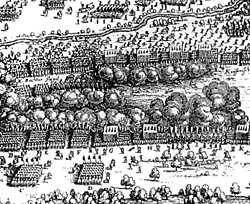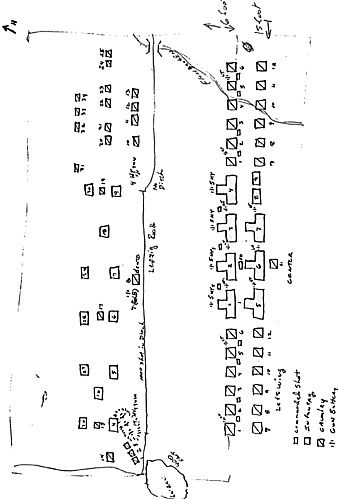 A small stone marker on a two lane blacktop outside a little
provincial town is the only sign of the battle that decided the
fate of western religion and Germany. on that stone marker are only
the words " Freedom of conscience for all the world." Lutzen has
been called " the most decisive draw in history" but the battles'
affects were both immediate and lasting. Mr. Michael Roberts wrote
that " it (Lutzen) inaugurated a period ,if a century and a half
when war would be divorced from idealism, and politics emptied of
faith." After Lutzen, dynastic ambition (or survival) would take
precedence over religious questions, but only because the draw at Lutzen.
A small stone marker on a two lane blacktop outside a little
provincial town is the only sign of the battle that decided the
fate of western religion and Germany. on that stone marker are only
the words " Freedom of conscience for all the world." Lutzen has
been called " the most decisive draw in history" but the battles'
affects were both immediate and lasting. Mr. Michael Roberts wrote
that " it (Lutzen) inaugurated a period ,if a century and a half
when war would be divorced from idealism, and politics emptied of
faith." After Lutzen, dynastic ambition (or survival) would take
precedence over religious questions, but only because the draw at Lutzen.
A win by Wallenstein and the Imperialists would have pushed through their program of conversion. Sweden was the Protestants' last sword and a loss at Lutzen would have broken the 'Lion of the Norths' army.
A win by Sweden would mean Imperial power would be broken beyond recovery, and large portions of Germany would be at least Swedish satellites.
Only the draw, and Gustavus's death, re-established the military balance and permitted a third party to evolve under Saxon leadership. Also, Wallensteins' execution of 17 officers in the aftermath created the opening for Ferdinand to regain influence in Wallensteins' camp, leading to Wallensteins' assassination. This permitted Ferdinand to regain control and insured that the Austrian Hapsburgs' could at least control Catholic destiny in Germany.
The war would continue for 16 more years.
1632 Campaign Leading up to Lutzen
The campaign was one of strategic maneuver between Gustavus and Wallenstein. Gustavus at first wanted to draw Wallenstein to Bavaria, or at least strenghten his hold to the point that he would have a firm base from which to finish the war in Austria the following year. Wallenstein attempted to threaten Swedens' line of communications with the Baltic Sea, first by besieging Nurnberg; and then by invading Saxony. Both generals displayed real flair as the cat and mouse game of maneuver continued into winter. Wallenstein, with his mercenaries ready to revolt or desert, was forced into winter quarters, secure in the knowledge that his larger army was blocking Swedens' communications. What he failed to consider was that Gustavus considered this a perfect time to attack and achieved tactical surprise.
PLAYER NOTES
Wallenstein must hold until Pappenheim can ride to the rescue. The Swedes must render Wallensteins' position untenable before Pappenhein arrives. The fate of Germany hangs in the balance.
ORDER OF BATTLE. SWEDEN
COMMANDING Gustavus Adolphus
Left Wing: First Line. Bernhard of Saxe-Weimar
Second Line. Ernst of Anhalt
Center: First Line. Nils Brahe
Second Line. Dodo von Knyphausen
Right Wing: First Line. Tortsen Stalhandske
Second Line. Zorn von Bulach
Artillery. Four (five gun) heavy batteries; one in front of
each first line Swedish brigade. 40 regimental guns; 10 per
Cavalry Wing and the remainder divided up between each infantry
brigade.
Commanded shot. 4 (6 figure) shot elements per cavalry wing
and 4 (including nr. 10 Henderson) supporting the infantry.
LEFT WING, first line
1. Courville Cuirass. 8 figures.
Regular.
2. Tiesenhausen Cuirass. 8 figures. Elite. Livonians,
possibly formerly Tott's. Green and Black uniforms.
3. Donhoff Cuirass. 8 figures. Veteran.
Courlanders. Green and balck uniforms.
4. Karberg Cuirass. 8 figures.
Regular.
5. Berhard Cuirass, 8 figures. Elite.
Thuringer.
6. Berhard Cuirass. 8 figures. Veteran.
Thuringer.
Left Wing, second line
7. Steinboch Cuirass, 4 figures.
Regular.
8. Stecheintz Cuirass. 4 figures.
Regular.
9. Lowenstein Cuirass. 4 figures.
Militia.
10. Brandenstein Cuirass. 4 figures. Militia. Weimarians.
11. Anhalt Cuirass. 8 figures. Regular. Saxon with white
and gold uniforms.
12. Hofkirchen Cuirass. 8 figures. Regular. Saxon with
black and gold uniforms.
CENTER first lin
1. Green Brigade (not the famous Green Bde, it is in
Bavaria) Berhards Reg. Thuringer Wildenstein Reg.
Formerly Halls' Reg. that fought at Breitenfeld. Raised
at Emden as one of the Black Reg. Leslies' Reg. Made up
of Scots and remnants of 'Capt.Luckless' Hamiltons Reg.
Wildensteins may be in black, Leslie as Scot or english
uniforms. 16,16,16 figures. Veteran
2. Blue Brigade (Blue uniforms) Elite
Winkles' Reg. (Poss Red Reg. also) The old Blue Reg.
Raised by Brandenberg to fight the Swedes! as Bbergs
feudal obligation. They joined the Swedes at the first
chance. 12,16,12 figures.
3. Yellow Brigade (yellow uniforms) Elite
Brahes Yellow Reg. and the Lifeguard. The lifeguard wore
black and gold. 11,11,10 figures.
4. Kyles Swedish Brigade Elite
Gabriel Kyle Gotlanders 10 fig.
Karl Hard Gotlanders 11 fig.
Axe Oxenstein Dalarna and Uppland 11 fig.
10. Henderson Reg. (commanded shot.) Scot/English in
reserve for first line. 6 figures.
CENTER second line
5. Mitslaff Brigade regular
Mitslaff Reg. raised in Franconia. 16 fig.
Gersdorf Reg. German 16 fig.
Rosen Reg. German/poss. some Saxon 16 fig.
6. Thurn Brigade Regular
Thurn Reg. German/ Bohemian exile 11 fig.
Wilhelm vom Hessen Green Reg. Hessian guard. 10 fig.
Isenberg Reg. german? 11 fig.
7. Knyphausen Brigade Veteran
White Reg. Formerly Hanse (Stettin and Emden ) troops
raised by Dodo and also Mitschefalls Reg. who filled out
the Whits Reg. after the former commanded was executed
for surrendering Rain. 10,11,11 fig
8. Pforte/Bose Reg. Saxon Reg. in yellow and black uniforms.
Pfortes Reg. formerly the Starshedal Reg. 24 fig. milita
Poss. changed to blue and red uniforms.
9. Wilhelm of Saxe Weimar Green Reg. Guard Unit. 24 fig.
miltia
11. Ohms' Cuirass. 5 figures. Veteran.
LEFT WING
First
line
1. Stenbock Med. Cavalry . Regular. 4 figs. (Smaland)
Blue?
2. Speruetter Cuirass. veteran. 8 figs. (Uppland)
Red?
3. Silversparre Med. Cavalry. Elite. 8 figs. Swedish
nobles.
4. Sack Med. Cavalry. Regular. 4 figs. Regular
(Sondermanland) Yellow?
5. Knut Soop Cuirass. Veteran (Vastergotland)
Grey?
6. Stalhandskes' Finns. 10 figures. Elite. Orange ?
This was the Swedish cavalry and probabley NOT uniformed,
colors mentioned are only guides.
Second line
7. Uslar Cuirass. 4 fig. regular. Hessians
8. Dalwag Cuirass. 4 fig. Regular. Hessians
9. Beckerman Cuirass. 4 fig. Militia. Poss. Saxon but only one source implies so.
10. Zorn von Bulach Cuirass. 4 fig. Militia. German
11. Goldstein Cuirass. 4 fig. Militia. once in the Saxon
army, at that time in yellow and black.
12. Duke William of Saxe-Weimar Cuirass. 4 fig. Militia.
As the Duke was sick and not in commmand at Lutzen, causing
Berhard to move up the command structure, I don't know who
was in charge of this guard unit.
WALLENSTEINS ARMY AT LUTZEN
COMMANDER Albricht Waldstein
Left Wing Colloredo
Center Trka
Right wing Holck
Re-enforcments Pappenhein
Right
Wing
1. Tontinelli Bavarian Cuirass. 6 fig.
Milita.
2. Lohe Cuirass. 6 fig.
Regular.
3. Des Fours Cuirass. 8 fig.
Veteran.
14. Westphalen Arquebus. 8 fig.
Regular.
15. Loyers Arquebus. 8 fig.
Regular.
Center
4. B. Waldstein Reg. 24 fig. Veteran.
(nepotism)
5. Grana Reg. 24 fig. Veteran. Chech
supporter.
6. Comago/Reinach Reg. 24 fig. Veteran.
Bavarian.
7. Cheisa Reg. 24 fig. Veteran. Chech
supporter.
8. Trka Dragoons. 8 fig. Veteran.
Dismounted.
9. Alt Sachsen Reg. 16 fig. Regular. (Name implies
Saxons)
26. Baden Reg. 14 fig. Regular. (Name implies Baden)
16. Trka Reg. 16 fig. Veteran. Chech
supporter.
27. Colloredo Reg. 16 fig. Elite. Poss.
raised in Italy.
28. P.F. von Bruener Reg. 14 fig. Veteran. Chech
supporter.
29. P.F. von Bruener Reg. 14 Fig. Veteran. Yes, two
Regiments.
17. Wallensteins Lifeguard Lancers. 5 fig. Elite. Red and
light blue uniforms.
18. Mansfield Reg. 16 fig. Regular. Not THE Mansfield but
from Luxembourg and the legitiment side of the family.
30. H.G. Von Bruener Reg. 14 fig. Militia. Chech
supporter.
19. Leutersheim Arquebus. 8 fig.
Militia.
Left Wing
31. Baggage boys pretending to be Cuirass. 1 or 2 to
Spot.(D6)
10. Gotzen Cuirass. 6 fig.
Regular.
11. Piccolomini Cuirass. 8 fig.
Elite.
12. Piccolomini Cuirass. 8 fig.
Veteran.
13. Piccolomini Arquebus. 8 fig.
Veteran.
20. Haagen Arquebus. 8 fig.
Peasant.
21. Haagen Arquebus. 8 fig.
Peasant.
22. Goshutz Cuirass. 6 fig.
Militia.
23. Holck Cuirass. 6 fig.
Elite.
24. Alt Trka Cuirass. 8 fig.
Veteran.
25. Alt Trka Cuirass. 8 fig.
Veteran.
Croat Light Horse
32. Beygott. 8 fig.
Militia
33. Isolani. 8 fig.
Elite.
34. Reway. 8 fig.
Militia.
30 commanded shot in the ditch in 5 (6 figure) units and 1
(8 figure) unit on the Lutzen walls.
Pappenheims' Detachment
Bredow Cuirass. 8 fig. Veteran
Sparr Cuirass. 8 fig. Veteran
Bonninghausen Arquebus. 8 fig. Elite.
Lamboy Arquebus. 8 fig. Regular.
Pappenheim/Merode Dragoon. 8 fig. Regular.
Orossy,Croat Light Horse. 8 fig. Militia.
Army Comparisons
Sweden. 12,800 foot and 6200 horse. 20 Heavy guns with
40 Regimental guns.
Wallenstein. 8500 foot and 7500 horse. 18 heavy guns and 6
light guns.
Pappenheim. 2300 to 3000 horse. 2500 foot that arrived
after dark.
TERRAIN
DITCH -1 to hit from fires. -1 melee. -1 morale roll.
soft cover= 1 rank pike. Cavalry at trot or 1 on d6 for
losses. No cavalry charge across. -2 inch move for all.
FLOSSGRABBEN -2 inch move. Cavalry at trot or 1 on 6d for
loss.
RIVER not
allowed
SWAMP Routing infantry only, at half
rate.
LUTZEN WALLS Hard cover. -2 to fire. no
melee
LUTZENImpassable, Wallenstein fired the town to prevent
movement through
BILBIOGRAPHY
The Military Intellectual and Battle: Raimondo
Montecuccoli and The Thirty Years War. NY STATE UNV. ALBANY
(1975)
The Thirty Years War. G. Parker. BARNES & NOBLE
(1984)
Gustavus Adolphus and the Rise of Sweden: 1611-
1632. LONGMANS (1953-1957) 2 vol.
The Troops of Electoral Saxony During the Thirty yaers
War. J. Belaubre.
OSPREY SERIES: # 235 & #
262.
Nafzigers' orders of Battle for The Thirty Years
War.
Wargames Illustrated # 79 & # 82
Renaissance Armies: 1480-1650. G. Gush. PATRICK STEPHENS
(1975).
Wargaming Pike and Shot. D. Featherstone. HIPPOCRENE. (1977).
THANKS
Many thanks to those who assisted in this project, the end result would have been much poorer without your assistance. Special thanks to those who lent figures: Joe Wilkerson, Scott Hansen, Troy Price, and David Yates.

Back to MWAN #105 Table of Contents
Back to MWAN List of Issues
Back to MagWeb Magazine List
© Copyright 2000 Hal Thinglum
This article appears in MagWeb (Magazine Web) on the Internet World Wide Web.
Other military history articles and gaming articles are available at http://www.magweb.com